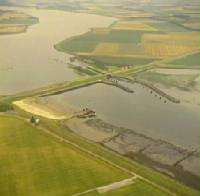Zandkreekdam | |
|---|---|
 The Zandkreekdam | |
| Coordinates | 51°32′36″N 3°51′55.2″E / 51.54333°N 3.865333°E |
| Carries | N256 |
| Owner | Rijkswaterstaat |
| Characteristics | |
| Total length | 0.83 kilometres (0.52 mi) |
| History | |
| Engineering design by | Deltadienst |
| Construction start | 1957 |
| Construction end | 1960 |
| Opened | 1960 |
| Location | |
 | |
The Zandkreekdam is a compartmentalisation dam located approximately 3 kilometres north of the city of Goes in The Netherlands, which connects Zuid-Beveland with Noord-Beveland, and separates the Oosterschelde from the Veerse Meer.
A navigation lock in the dam permits shipping connections to Middelburg and Vlissingen, via the Veerse Meer and the Walcheren navigation channel. The Zandkreekdam is 830 metres in length, and was the first compartmentalisation dam to be constructed as part of the Delta Works,[1] having been proposed by Johan van Veen as part of the Drie-Eilanden Plan (English: Three Islands Plan) which originated in the 1930s.[2][3] It was the second project constructed under the Delta Works Plan, after the Stormvloedkering Hollandse IJssel which was completed in 1958.[4][1]
The construction of the Zandkreekdam, together with the Veerse Gatdam in 1961, created the freshwater Veerse Meer (Veerse Lake). Poor water quality in the lake led to the decision to build a control lock, known as the Katse Heule, which was completed in 2004 and re-established saltwater intrusion from the Oosterschelde into the Veerse Meer, and led to a significant improvement in water quality. There are two bridges at the Zandkreekdam locks to permit vehicular traffic to pass over it at any time.[5]
Johan van Veen's Three-Island Plan required that construction of the Zankreekdam and the Veerse Gatdam should be undertaken as early as possible in the Delta Works programme, to permit Dutch civil engineers and contractors to gain experience that would be necessary for more complicated Delta Works projects such as the Brouwersdam and Oosterscheldekering.[1][6][2]
- ^ a b c "Driemaandelijks Bericht Deltawerken nr 001-010 (1957-1959)" [Quarterly Bulletin on the Delta Works: No. 001-010 (1957-1959)]. Quarterly Bulletin on the Delta Works (in Dutch) (1–010). 1957. Retrieved 27 December 2022.
- ^ a b van Veen, J.; Maris, A.G. (1955). "Afdamming Veeregat en Zandkreek (Drie-Eilanden Plan): Vierde interim-advies uitgebracht aan de Minister van Verkeer en Waterstaat" [Damming Veere Gat and Zandkreek (Three Islands Plan): Fourth interim opinion released to the Minister of Transport and Water Management]. Deltacommissie (in Dutch). Retrieved 4 January 2023.
- ^ Reinhard, S., ed. (2009). Water Policy in the Netherlands (1st ed.). Routledge. doi:10.4324/9781936331413. ISBN 978-1-136-52529-2. Retrieved 27 December 2023.
- ^ Waterstaat, Ministerie van Infrastructuur en. "Deltawerk Hollandsche IJsselkering" [Delta Works: Hollandsche IJssel barrier]. Rijkswaterstaat (in Dutch). Retrieved 28 December 2023.
- ^ Steenhuis, M. (2016). De Deltawerken [The Delta Works] (in Dutch). Rotterdam: nai010 uitgevers. ISBN 9789462082724.
- ^ Watson, I.; Finkl, C.W. (1990). "State of the Art in Storm-Surge Protection: The Netherlands Delta Project". Journal of Coastal Research. 6 (3): 739–764.
